I Dig Sports
Tyrrell Hatton still battling wrist, but off to solid start in first event since November

MEXICO CITY – The WGC-Mexico Championship features the world’s best players so it should be no surprise when any particular player finds himself in contention. Tyrrell Hatton might be the exception.
The World Golf Championship is Hatton’s first start anywhere in the world since the European Tour’s finale in November. He’s been sidelined since then following off-season surgery on his right wrist.
Considering his nearly three months of inactivity it’s understandable if Hatton’s rounds of 69-68 were very much a pleasant surprise.
“[The wrist] is a lot better than it was. It's still not 100 percent,” said Hatton, who is tied for seventh place at 5 under par, six off the lead.
Hatton said he still feels a “twinge” in his wrist while he’s warming up but is pain-free on the golf course.
“Obviously the back end of last year, every club was uncomfortable, so I'm kind of glad that's behind me," he said, "and hopefully I can move forward and the wrist gets back to 100 percent."

Tottenham Hotspur manager Jose Mourinho said he believes finishing in the top four with this Tottenham team will be a greater achievement than finishing as runner-up with Manchester United in the 2017-18 season.
Mourinho had previously said that the season with United was the greatest of his career because "people don't know what is going on behind the scenes."
- ESPN Premier League fantasy: Sign up now!
- VAR in the Premier League: Ultimate guide
- When can Liverpool win the Premier League?
- When does the transfer window re-open?
However, he has faced a crisis with his forwards this season with both Harry Kane and Son Heung-Min facing extended periods on the sidelines with injury.
When asked at a news conference on Friday if top four success would top his 2018 achievement, Mourinho replied: "In these circumstances? Yes.
"Son and Harry score the majority of goals that Tottenham score. This season was so negatively special that we are going to be without them both at the same time and for a lot of matches so yes [it will be a great achievement].
"Not just for me. Not my achievement. Collectively for the team. For the boys, if we manage in fourth without Harry and Son will be something incredible. It will be an incredible achievement for the boys so we have to give everything we have."
Mourinho returns to Stamford Bridge on Saturday to face Frank Lampard's Chelsea but the former Blues manager has played down the occasion.
"Not special. One more game," Mourinho said. "As I told my previous club, I belong 200% to the club.
"The only difference would be at the end of the game I could walk from the stadium to my house.
"But even that I would not take advantage of because I will come back here for my players."
Southee and Jamieson take four each to knock over India for 165
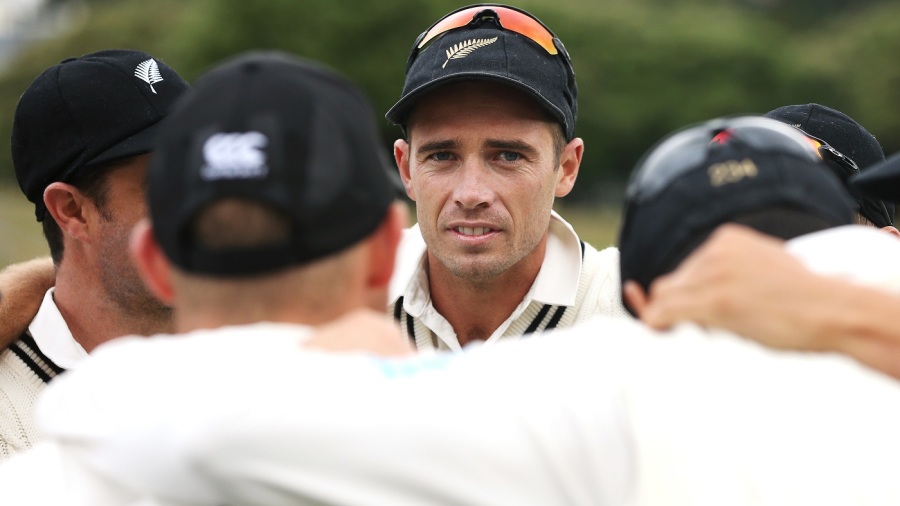
India 165 (Rahane 46, Jamieson 4-39, Southee 4-49) v New Zealand
In bright sunshine on the second morning, Ajinkya Rahane and India had a strange half session of Test cricket. Rahane first ran Rishabh Pant out, then got out caught at the wicket when leaving the ball, and India lost five wickets for the addition of just 43 runs. After Kyle Jamieson's excellent debut on the first day, it was the veteran Tim Southee causing most of the damage on the second morning, that too running into the wind.
In the fourth over of the day, Rahane looked for a typical quick single after hitting to point. It should have been Pant's call, but Rahane kept on running, which meant the lesser batsmen of the two had to risk his wicket by running as well. Unfortunately for Pant, Ajaz Patel's shy from point hit the only stump visible just about hard enough to nudge the bail off. The next ball was a perfect outswinger from Southee, hitting that same stump to send R Ashwin back. This was a repeat of the Prithvi Shaw dismissal; neither of these batsmen likes a big front-foot movement.
Rahane had been superb in defence on the first day, but now he had to open up a little since he had the tail for company. A top edge off Trent Boult fell just short of fine leg before Southee went wide on the crease to create confusion. Rahane knew he had to cover for the scrambled-seam inswinger too, which meant he was late in withdrawing the bat as he left an outswinger alone. It was enough for the ball to kiss the inside edge and dismiss Rahane four short of a fifty.
Mohammed Shami went on to frustrate Southee for a bit, but in the end the last two were split by Jamieson and Southee.
Wilder (231 lbs.) heaviest of career; Fury at 273
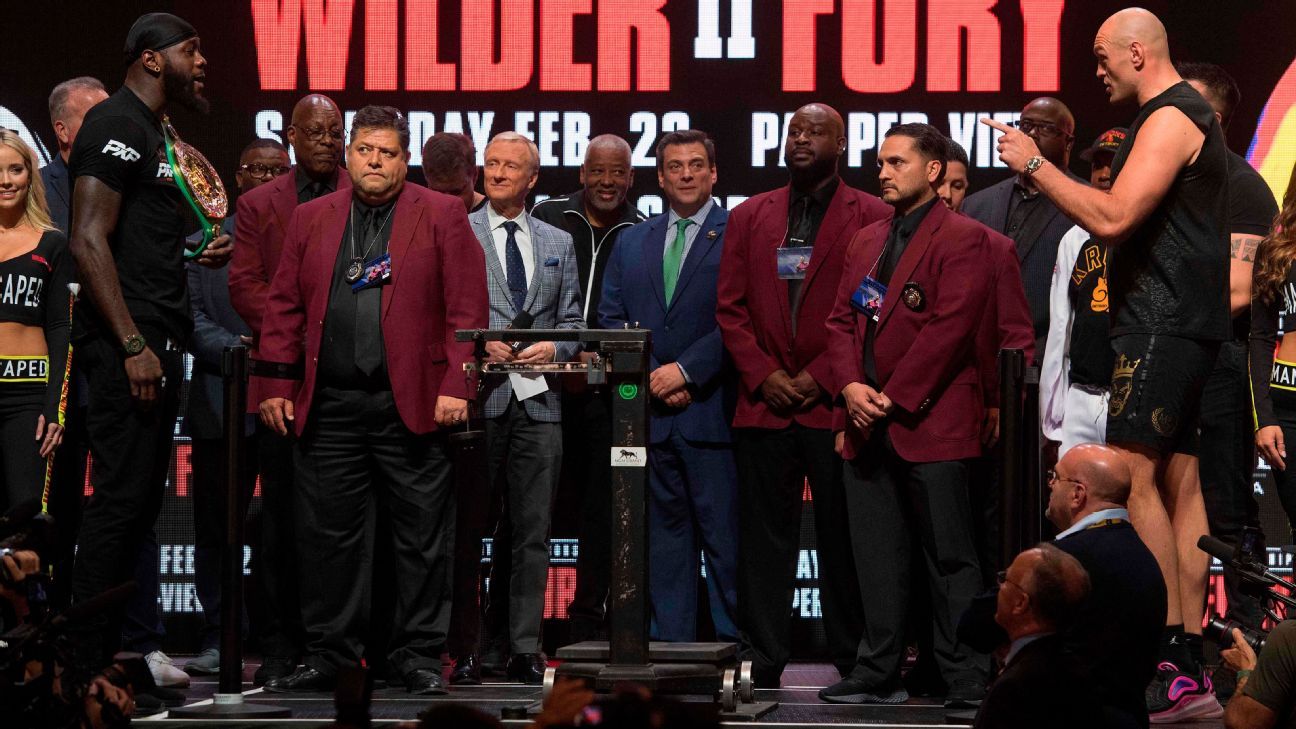
LAS VEGAS -- Hoping to avoid a repeat of the pushing and shoving that took place between heavyweight world titleholder Deontay Wilder and lineal champion Tyson Fury at their final pre-fight news conference on Wednesday, the Nevada State Athletic Commission mandated that the big men would not be permitted to face off for the traditional photo following their weigh-in on Friday.
So even though the fighters were kept apart by about 10 feet on a long stage, the rollicking crowd at the MGM Grand Garden Arena cheered, sang and partied in anticipation of perhaps the biggest heavyweight championship fight since Lennox Lewis retained the title in his long-awaited showdown against Mike Tyson in 2002.
Fury and Wilder made separate walks through the floor of the arena to music to the wild cheers of their fans before hitting the scale ahead of the heavily anticipated rematch, also inside the MGM Grand Garden Arena, on Saturday (ESPN-Fox PPV, 9 p.m. ET).
Fury weighed in first and was a solid 273 pounds, the third heaviest of his career. He weighed 276 for his return from a 31-month layoff against Sefer Seferi in June 2018 and was 274 for a 2014 bout against Joey Abell.
Wilder was the heaviest of his career, a ripped 231 pounds. He had been as heavy as 229 for two previous fights, his first title defense against Eric Molina in 2015 and for a 2012 win over Damon McCreary.
NBA reschedules Lakers-Clippers tilt for April 9

LOS ANGELES -- The Los Angeles Lakers' game against the LA Clippers that was postponed following the helicopter crash that took the lives of Kobe Bryant, his daughter Gianna and seven others has been rescheduled for April 9 at Staples Center, the league announced Friday.
The game, which originally was scheduled for Jan. 28, will tip off at 10:30 p.m. ET and will be broadcast on TNT.
The league had to change three games on its master schedule in order to accommodate Lakers-Clippers. As a result, the Lakers will play three consecutive home games from April 7-9.
The last time a team played three days in a row was in March 2018, when the New Orleans Pelicans did so after their game against the Indiana Pacers in February 2018 had to be rescheduled because of a leak in the roof of the Smoothie King Center.
The NBA moved Warriors-Lakers, previously scheduled for April 9, to April 7. It also moved Bulls-Lakers, previously scheduled for April 7, to April 8.
The Clippers and Bulls, previously scheduled to play on April 8, will instead play a rare game on the same night as the NCAA men's basketball championship game on April 6. Typically the NBA does not hold games on the same night at the NCAA men's championship game.
By moving their game against Chicago from the originally scheduled date of April 8 to April 6, the Clippers will shift their back-to-back set to a home and away with the Bulls home game coming before a game at Utah on April 7. After a day off, the Clippers face the Lakers on April 9 to play three games in four nights.
ESPN's Ohm Youngmisuk contributed to this report.
Towns out at least 2 weeks with broken left wrist
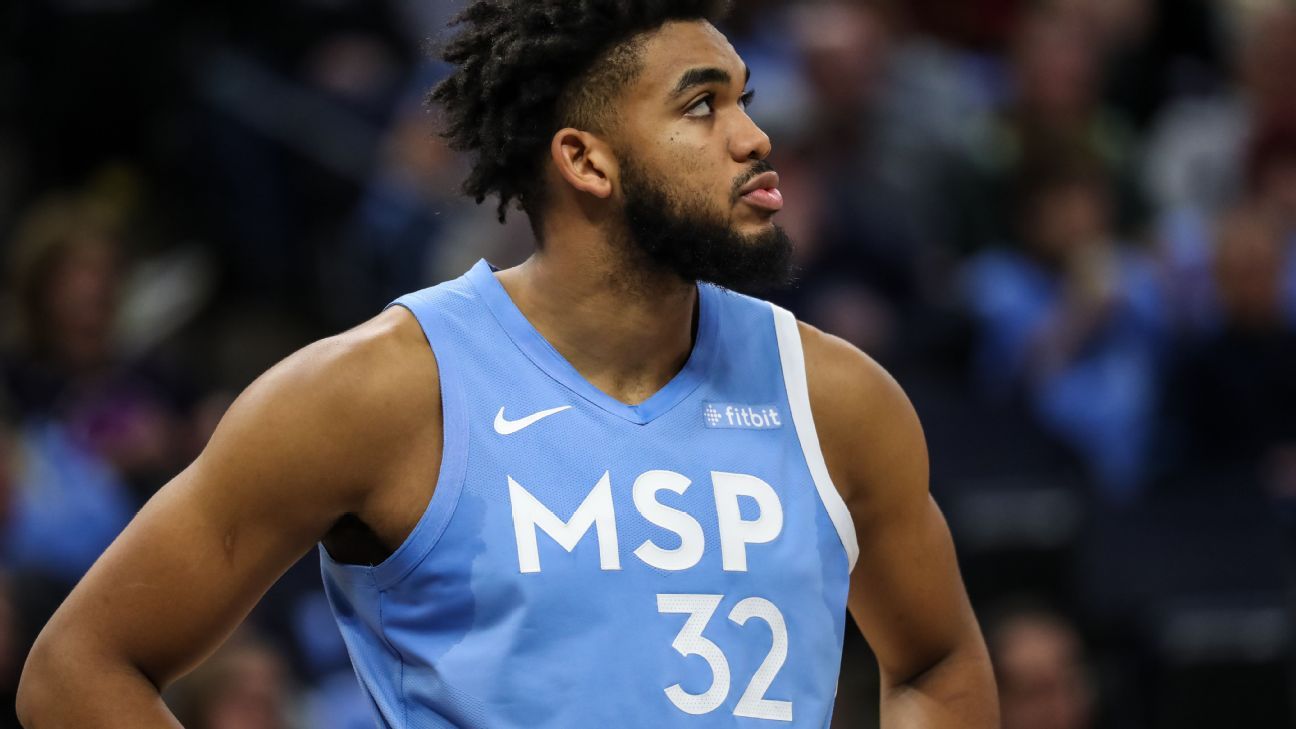
Minnesota Timberwolves center Karl-Anthony Towns has a fractured left wrist and will be out for at least the next two weeks, the team announced Friday.
Towns missed Minnesota's final game before the All-Star break after an MRI revealed a wrist injury. He will be re-evaluated in two weeks.
Towns is averaging a career-best 26.5 points and 10.8 rebounds per game this season.
The injury means the Wolves will have to wait to see how the team looks with Towns playing alongside newly acquired point guard D'Angelo Russell.
Towns, who had been an iron man in his first three seasons, missed 15 games earlier this season with a sprained left knee.

After leaving Memphis in December in the aftermath of an eligibility battle with the NCAA, potential No. 1 overall NBA draft pick James Wiseman described the saga as "heartbreaking" and said his NCAA punishment was "unfair."
In his first interview since leaving school to turn professional, Wiseman told ESPN that he cried every night in his dormitory room during the turbulent episode with the NCAA, ultimately leaving school amid a 12-game suspension for rules violations that Wiseman insists he hadn't been aware occurred.
"I was really in the middle of a hurricane," Wiseman told ESPN in an interview that aired Friday. "That's like the worst place you could possibly be. Just having the mental agony and the suffering, crying every night because I just wanted to get on the court so much."
The NCAA punished Wiseman because his family accepted $11,500 in moving expenses in 2017 from Penny Hardaway -- who was then the coach of Memphis East High School. While Hardaway didn't accept a job at the University of Memphis and recruit Wiseman to campus until 2018, the NCAA deemed Hardaway a university booster at the time of the financial support. Hardaway had donated $1 million in 2008 to the university, where he had starred in the 1990s.
Despite the NCAA warning Memphis that it could face penalties that included forfeitures by playing an ineligible player after Wiseman had been eligible for the opening game, Wiseman and his attorneys won a temporary restraining order, which led to him playing two more games to start the Tigers' season.
Wiseman eventually dropped the restraining order, and Memphis applied for reinstatement to the NCAA. On Nov. 20, Wiseman accepted a 12-game suspension that included repayment of the $11,500.
A month later, Wiseman announced that he would leave the team and school and turn his attention to preparing for the June NBA draft. Wiseman signed with Excel Sports for his professional representation and remains a strong possibility to become the No. 1 overall pick.
"I wanted to have a great collegiate career," Wiseman told ESPN. "I wanted to win a national championship. But throughout the course of the first two games, everything started to go down in terms of my mental [well-being]. I was getting depressed. It was dehumanizing for me.
"I felt it was unfair because they notified and alerted me at the last minute. Coach Penny told me about it. I was really down and shocked. When I got suspended for 12 games and had to pay back the money, that was kind of surreal. I didn't really have any knowledge of [the violation] or all the ramifications behind it."
Asked why he had his lawyers drop the temporary restraining order that allowed him on the court despite the NCAA's warnings, Wiseman said, "I didn't want it to get worse in terms of it coming back on the institution, on the University of Memphis."
Wiseman cited an inability to pay back the $11,500 and the threat of potential injury as reasons for ending his college career prematurely.
"It was a bit surreal because I couldn't use a GoFundMe page that [ESPN's] Jay Williams put out for me, obviously," Wiseman told ESPN. "I couldn't use any outside sources. I had to get [the money] on my own, and that was pretty impossible because I didn't have the money. I was just a regular college student."
As for deciding against returning following the suspension, Wiseman said: "You could also say injury risk. I just cared about my longevity and my future. I had to make a decision on my own, and my family supported me."
Wiseman expressed disappointment over never getting the chance to pursue a national championship with his Memphis teammates.
After playing in the season opener against South Carolina State, Wiseman had to spend several hours in a Memphis courtroom pursuing a temporary restraining order so he could play in the Tigers' second game against Illinois-Chicago. He arrived at the arena only minutes prior to the opening tip of the nationally televised game.
"I didn't think that I was going to be in the courtroom that long," Wiseman told ESPN. "So Coach Penny came in, trying to prep me up for the game, but mentally, I was just out of it. It really took a lot out of me. I got to the arena at like 6:30, or 6:45, and the game was at 7. ... It reminded me of the AAU days when you'd come to a game 10 minutes early."
Wiseman would play in one more game, against Oregon, before dropping the restraining order and eventually seeing his college career come to an end.
He said he spoke with an NCAA official during the investigation by phone in a university administration office. Asked what the NCAA discussed with him, Wiseman told ESPN that they asked, "Did you take the money? Is Penny Hardaway actually a booster? Just stuff I had no knowledge of, especially when that $11,500 came out. I didn't have any knowledge of that. Questions that were ... false assumptions that really didn't make sense at all."
Wiseman said his relationship with Hardaway and his former Tigers teammates hasn't suffered because of the scandal and departure.
"It didn't change at all," Wiseman told ESPN. "We have a great relationship. We go way back. ... I didn't want to leave my teammates. I wanted to stay at the University of Memphis. [But] the mental depressing coming from [all] of it, having to deal with the media every day, it was a lot of mess for no reason.
"But I really wanted to stay at the University of Memphis. I really love those guys. I really love my coaches. But I had to make a decision on my own."
Wiseman has set up base in Miami and is working out twice a day in preparation for the June 25 draft. One historic player who shares a similar height, wingspan and left-handed shot has caught Wiseman's attention as he prepares for the pros, he said: Hall of Fame San Antonio Spurs center David Robinson.
"I'm trying to gain some weight and keep my body healthy," Wiseman said. "I study a lot of film. Anthony Davis. Dirk Nowitzki. Karl-Anthony Towns. A lot of players who can shoot the ball at my height. I'm working on my shooting mechanics, trying to get my shot right."
As for the race to emerge as the No. 1 overall pick, Wiseman likes his chances.
"I truly expect that," he said. "I trust in myself, in terms of my game and my skill level. I've just to keep working, keep grinding every day."
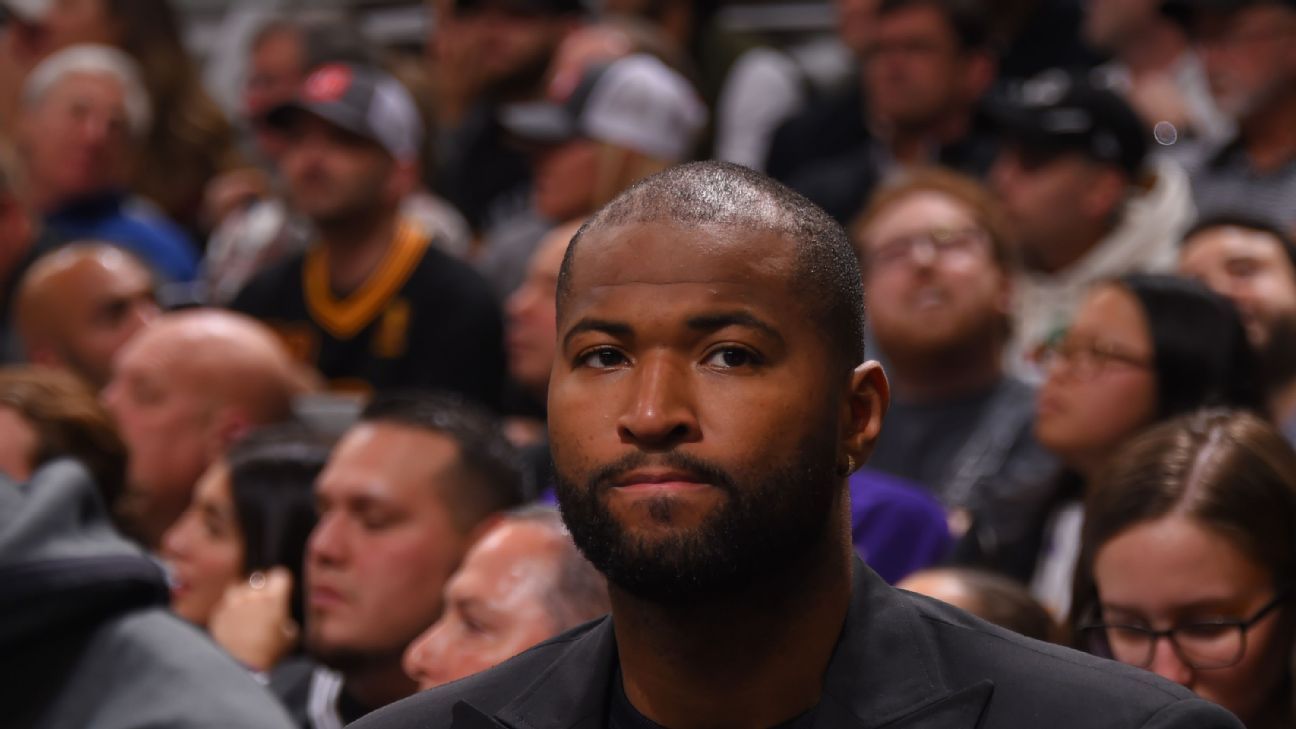
The Los Angeles Lakers intend to waive DeMarcus Cousins to clear a roster spot for Markieff Morris, if he clears waivers on Sunday, sources told ESPN's Adrian Wojnarowski and Ramona Shelburne.
Morris negotiated a buyout with the Detroit Pistons on Friday, leaving $4.3 million (the remainder of this season and his 2020-21 salary) on the table, according to ESPN's Bobby Marks.
Cousins, a popular player in the Lakers locker room, has missed the entire season with a torn ACL in his left knee. Earlier this season, the Lakers successfully applied for a disabled player exemption for Cousins, because the injury was expected to keep him out the entire season.
The disabled player exemption is worth $1.75 million, which is significantly higher than the prorated minimum of $694,702 the Lakers could offer a player who has been waived at this point of the season.
Morris, 31, has appeared in 44 games for the Pistons this season, averaging 11 points and 3.9 rebounds per game. He's able to play both forward spots and is a good rebounder and defender. Over nine seasons, he's averaged 11.6 points, 5.4 rebounds and 1.7 assists in 623 games.
Lakers coach Frank Vogel said over the All Star break there was a chance Cousins could return for the playoffs, but noted Thursday, "I'm not even sure where he's at with exactly what he's doing day-to-day. I just still know he's a long way away, but they've said they're not ruling out him returning."
Morris' twin brother, Marcus, plays for the crosstown rival LA Clippers.
"That's my brother man. Man, if he goes to LA, then I'm gonna be in Staples Center all the time. I think maybe to y'all it might be weird that I'm going to all his games, but that's what'll probably happen. And we'll probably get a house together.
"If one of us wins, we both win. That's how we look at it. Obviously, I'm a Clipper, I'd love to win, we're definitely gonna be competitors, but we're both gonna work hard. It'll probably be the first time where two players from two different teams are actually working out together. That's gonna be cool."
Cousins will likely not be waived until Sunday night after Morris clears waivers, Marks reports. Cousins has roughly $1 million left on his $3.5M contract. A claiming team would have non-bird rights and could offer him a contract up to $4.2M (or midlevel exception/cap space) as a free agent.
Cousins is a four-time All-Star with the Sacramento Kings, New Orleans Pelicans, Golden State Warriors and Lakers.

Houston Astros players have gotten threats "every day" since the team's 2017-18 sign-stealing scheme came to light in recent weeks, according to outfielder Josh Reddick, who said Friday that messages he has received also targeted his family.
"You just see the first things in your suggested box and it just says, 'I will kill your family. I will kill your kids. Blah blah blah,'" Reddick said. "It's depressing to read because it's over a game of baseball. It's not worth that kind of drastic measure."
Reddick, who did not take part in the trash-can banging scheme, said the threats he has received so far were limited to only social media. He spoke about his experiences one day after former Astros pitcher Mike Fiers, who revealed to The Athletic in November that the Astros were stealing signs in violation of MLB rules, said he had received death threats.
As he enters his 12th major league season and fourth with the Astros, Reddick said he expects to hear more from fans about the issue both on and off the field, to the point where he thinks "it could be very dangerous outside of the ballpark to even bring your family."
"There are ways to add security to a lot of places on the road whether it be in our hotels, on the way to the field," he said. "At the field, obviously, being a lot more hostile environment. Be a little crazier. I think, also, at the hotels because you see a lot of people line up at our hotels. They know where we stay, they know what times we usually go to the ballpark. And what time we get back.
"For me, myself having almost 5-month-old boys, it is going to be pretty scary because my wife is going to go want to come on a lot of road trips just because wanting to have my help in raising them and do our parenting thing. So it is definitely something you can think about every night."
Tony Clark, head of the Major League Baseball Players Association, met with the Astros in West Palm Beach, Florida, for nearly four hours Friday, then spoke to reporters.
Clark talked about the concerns of Houston's players, saying, "There are undoubtedly concerns out there based on some of the commentary. ... There's a heightened sense of concern to make sure that themselves and their families are protected.
"There's no doubt making sure that our players and their families are able to go to and from the ballpark and perform safely is a huge piece of the puzzle," he said.
Astros players won't necessarily be safe when the games begin, as pitchers such as the Cleveland Indians' Mike Clevinger and the Los Angeles Dodgers' Ross Stripling have hinted at the possibility of throwing at Houston batters.
Los Angeles Angels star Mike Trout this week joined a long list of players who have been critical of the Astros' actions, saying he "lost some respect for some guys." Reddick said he didn't believe condemnation from opponents was adding fuel to the online threats, but he said he would like to see a more unified front in light of the messages.
"I think the best situation for us is to have our families be safe and ourselves be safe," Reddick said. "But yeah, I think player unity is going to be a big thing. Especially with the way things are going now and way things will be in a couple of years to renegotiate stuff. I think that is one way the players need to get united. I think the more we are one on the same page and united it is going to be better for the whole game. It may take time the way this thing is being handled right now. I think ultimately the family safety is a big issue right now."
For now, Reddick said his plan to deal with the most egregious messages is largely to "just avoid clicking on it," but he still gets angry when he sees people threatening his children.
"I put a post of my kid rolling over for the first time and I gotta look down there and see 'I hope your kid gets cancer,'" Reddick said. "It makes you really want to see that person in person. Really makes you want to go up to him and see what they would do if you put your face to their face and really get a little bit of retribution for yourself. Pisses you off."
Anna Hursey champions Global Climate Action

In recent years she has become an increasingly well known figure on the international stage, the image she portrays meets the needs of a promotional campaign.
United Nations Climate Change made the following announcement on Thursday 20th February.
Young Welsh table tennis phenom, Anna Hursey, has accepted an invitation to put her determination and growing prominence to work to help save the planet as a Young Champion of the UNFCCC Sports for Climate Action Framework.
Ms. Hursey, just 13 years old, is the youngest ever person to play sport for Wales at a senior level, first representing her country at age 10. In her role as Framework champion, she will help inspire her peers, young athletes, and fans to act on climate action.
“I am proud to be a Young Champion and am looking forward to working with UN Climate Change to help set sports on a path to a low-carbon future,” said Ms. Hursey.
Born in Carmarthen, Wales, in June 2006 to British and Chinese parents, Ms. Hursey is the youngest athlete ever to compete in the Commonwealth Games at a senior level—representing Wales at the Games in the Gold Coast, Australia, in 2018, when she was just 11.
More than 110 sports teams and organizations—including at the very top levels of sport—have signed on to the framework, agreeing to promote greater environmental responsibility; reduce the overall climate impact from sports; educate for climate action; promote sustainable and responsible consumption; and advocate for climate action through their communications.
In line with these five core principles enshrined in the Framework, and the aims of the Paris Climate Change Agreement, Ms. Hursey will strive to inspire her fans, community and government to raise their climate ambition in a united effort to limit global warming to 1.5 degrees Celsius.
By signing the Framework, sports teams and organizations pledge to play their part to ensure the sports sector is on the path to climate neutrality.
Speaking at the launch of the Framework in 2018, UN Climate Change Executive Secretary, Patricia Espinosa, explained that sports organizations and athletes are in a unique position in the race against climate change “because sports touches on every cross-section of society.”
Ranked top in Wales in the under-15 age category and second in the senior division, Ms. Hursey reports that her ambition is to become the world’s number-one female table tennis player and win a medal at the Birmingham 2022 Commonwealth Games and Paris 2024 Summer Olympics.
She is fluent in Mandarin and English and moved full-time to Tianjin China in 2019 to train with top Chinese players, to help fulfill her ambition. She returns regularly to the UK, where she has been showcased by the media.”
Currently in the under 15 girls’ world rankings, Anna Hursey is listed at no.16.
Less than one week ago, Hursey reached the quarter-final stage of the cadet girls’ singles event at the 2020 ITTF World Junior Circuit Premium Czech Junior and Cadet Open staged in early February in Hodonin. She was beaten by the champion elect, Japan’s Miwa Harimoto (5-11, 11-2, 11-5, 11-9).










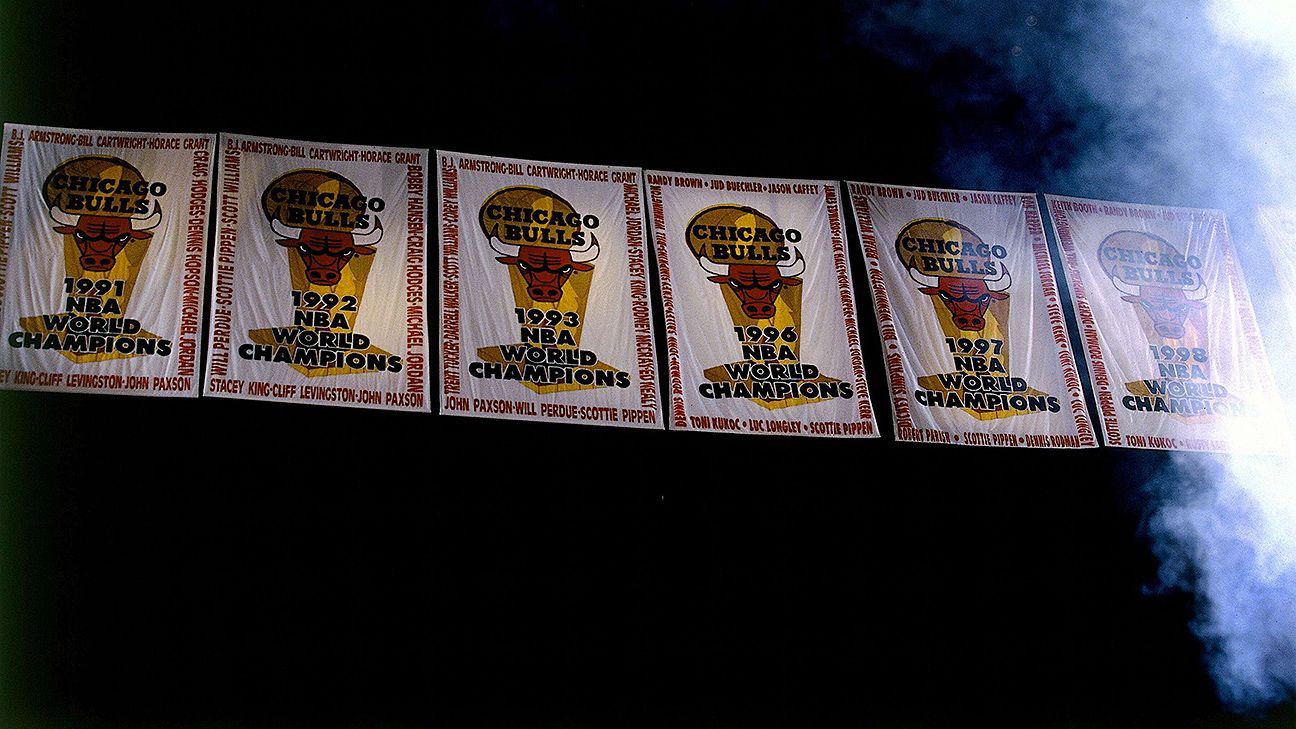




 Phone: (800) 737. 6040
Phone: (800) 737. 6040 Fax: (800) 825 5558
Fax: (800) 825 5558 Website:
Website:  Email:
Email: 






